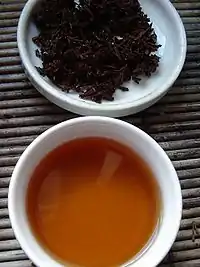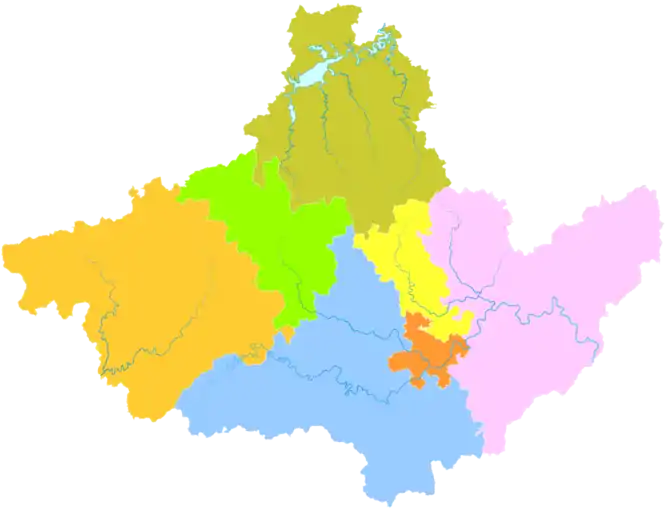Huangshan City
Huangshan (simplified Chinese: 黄山; traditional Chinese: 黃山; pinyin: Huángshān), is a prefecture-level city in Southern Anhui Province, People's Republic of China. Huangshan means Yellow Mountain in Chinese and the city is named after the famously scenic Yellow Mountains which cover much of the city's vast geographic expanse. The prefectural city of Huangshan includes three urban districts and four counties. The urban center of Huangshan was originally the city of Tunxi and is now called Tunxi District. Locals still call the city Tunxi to distinguish urban core from other parts of Huangshan.
Huangshan
黄山市 | |
|---|---|
 Reconstructed old town, Song Street | |
.png.webp) | |
| Coordinates (Huangshan municipal government): 29°42′54″N 118°20′15″E | |
| Country | People's Republic of China |
| Province | Anhui |
| County-level divisions | 7 |
| Township-level divisions | 145 |
| Municipal seat | Tunxi District |
| Government | |
| • CPC Secretary | Wang Qimin (王启敏) |
| • Mayor | Li Hongming (李宏鸣) |
| Area | |
| • Total | 9,807.4 km2 (3,786.7 sq mi) |
| Population | |
| • Total | 1,470,000 |
| • Density | 150/km2 (390/sq mi) |
| Time zone | UTC+8 (CST) |
| Area code(s) | 0559 |
| ISO 3166 code | CN-AH-10 |
| License Plate Prefix | 皖J |
| Website | www |
Huangshan occupies the southernmost part of Anhui. It is bordered by Chizhou to the northwest, Xuancheng to the northeast, Jiangxi Province to the southwest and Zhejiang Province to the southeast. Huangshan's history dates back to the time of the First Emperor. The city's current jurisdiction covers much of the historical and cultural region of Huizhou (徽州), which together with Anqing formed the name of Anhui Province. Huangshan is home to two UNESCO World Heritage Sites, Mount Huangshan and Hongcun and Xidi, the ancient villages of Southern Anhui. It is a major tourist destination in China.
Administration

The prefecture-level city of Huangshan administers 7 county-level divisions, including 3 districts and 4 counties.[1][2][3]
- Tunxi District (屯溪区)
- Huangshan District (黄山区)
- Huizhou District (徽州区)
- She County (歙县)
- Xiuning County (休宁县)
- Yi County (黟县)
- Qimen County (祁门县)
| Map |
|---|
These are further divided into 145 township-level divisions, including 58 towns, 43 townships and 4 subdistricts.[3]
Geography
Lower elevations of Huangshan City have a humid subtropical climate (Köppen Cfa), with short, cool winters and long, very hot and humid summers. At the central Tunxi District, the monthly mean temperature ranges from 4.4 °C (39.9 °F) in January to 28.1 °C (82.6 °F) in July, and the annual mean is 16.66 °C (62.0 °F). Precipitation is concentrated in spring and the earlier part of summer, and, at 1,739 mm (68.5 in) annually, is very high for the province, and more than double than the normal annual precipitation in northern parts of the province.[4]
| Climate data for Tunxi District, Huangshan (1981–2010 normals) | |||||||||||||
|---|---|---|---|---|---|---|---|---|---|---|---|---|---|
| Month | Jan | Feb | Mar | Apr | May | Jun | Jul | Aug | Sep | Oct | Nov | Dec | Year |
| Average high °C (°F) | 9.1 (48.4) |
11.6 (52.9) |
15.9 (60.6) |
22.2 (72.0) |
27.2 (81.0) |
29.7 (85.5) |
33.3 (91.9) |
33.1 (91.6) |
29.2 (84.6) |
24.0 (75.2) |
17.9 (64.2) |
11.9 (53.4) |
22.1 (71.8) |
| Daily mean °C (°F) | 4.4 (39.9) |
6.7 (44.1) |
10.7 (51.3) |
16.6 (61.9) |
21.6 (70.9) |
24.7 (76.5) |
28.1 (82.6) |
27.5 (81.5) |
23.7 (74.7) |
18.1 (64.6) |
11.8 (53.2) |
6.0 (42.8) |
16.7 (62.0) |
| Average low °C (°F) | 1.2 (34.2) |
3.3 (37.9) |
6.9 (44.4) |
12.5 (54.5) |
17.3 (63.1) |
21.1 (70.0) |
24.1 (75.4) |
23.7 (74.7) |
19.8 (67.6) |
13.9 (57.0) |
7.6 (45.7) |
1.9 (35.4) |
12.8 (55.0) |
| Average precipitation mm (inches) | 83.2 (3.28) |
109.9 (4.33) |
178.4 (7.02) |
209.7 (8.26) |
225.5 (8.88) |
313.9 (12.36) |
222.0 (8.74) |
122.6 (4.83) |
82.6 (3.25) |
69.8 (2.75) |
75.4 (2.97) |
46.1 (1.81) |
1,739.1 (68.48) |
| Average relative humidity (%) | 80 | 79 | 79 | 78 | 77 | 81 | 79 | 79 | 79 | 78 | 80 | 79 | 79 |
| Source: China Meteorological Administration[4] | |||||||||||||
Economy

Huangshan is famous for its tea, including Keemun tea, which is produced in Qimen County, and Maofeng green tea.[5][6] The city is also home to significant tourism, centered on Mount Huang and including other scenic and historic sites (such as Xidi and Hongcun),[5] which it has promoted to international markets in recent years.[7][8]
Transportation
Due to rugged terrain, Huangshan was historically a secluded region. The Xinan River provided an outlet to the east. Winding, narrow roads through Huang Mountains made trips to Xuancheng, Wuhu, Guichi and the Yangtze River slow and arduous. In recent decades, improvements to the transportation infrastructure have made the city and its surrounding tourist attractions more accessible.
Air
The Huangshan Tunxi International Airport, also referred to as the Tunxi Airport, is located in Tunxi District and is known by the IATA abbreviation TXN.[9] The airport was opened in October 1959, and has been expanded five times, including an expansion in 2000.[9] The airport offers regular flights to cities across China, as well as Seoul, Hong Kong, and Taipei.[9] The airport also offers chartered flights to Incheon, Nagasaki, Osaka, Fukuoka, and other regional destinations.[9]
Rail

Huangshan's main passenger station is now Huangshan North station, which is accessible via high-speed rail over the Hefei–Fuzhou high-speed railway and the Hangzhou–Huangshan intercity railway. Trains run from Huangshan to many cities.
Until 2015, Huangshan City was served by one railway line, the Anhui–Jiangxi Railway.[5] The line, which was completed in 1982 and has stations in Jixi County, She County, Tunxi District, Xiuning County, and Qimen County. Trains formerly ran from Huangshan Station in Tunxi to Nanjing, Shanghai, Bengbu, Huaibei, Qingdao and Beijing among other cities in the north, and stops in the south included Jingdezhen, Yingtan, Fuzhou, Xiamen, Guangzhou, Shenzhen, and Kunming. Trains still run to Beijing West, Hefei and Wuhu.
Road
Major expressways which pass through Huangshan City include the G56 Hangzhou–Ruili Expressway, the G3 Beijing–Taipei Expressway, and National Route G205.[5]
The Hefei-Tongling-Huangshan Expressway heads north to Tongling on the Yangtze River and then to Hefei, the provincial capital of Anhui.[10] The Huangshan-Taling-Taolin Expressway and Anhui Provincial Route S326, also pass through the city.[11]
Cultural history
In the Ming dynasty, Zheng Zhizhen (鄭之珍; 1518–1595), a native of Qimen County, wrote the opera Mulian Rescues His Mother[12][13] According to local legend, Zheng was blind when he wrote the opera and was restored to full sight by a grateful Guanyin (the legend also has it that when Zheng later wrote a love story he went blind again).[14]
In 2011, Local authorities promoted performance of the Ming dynasty play Mulian Rescues His Mother as a tourist attraction.[15]
Other notes
In early 2008, the BBC broadcast a series of 5 documentaries on life for schoolchildren in China, called "Chinese School". One of the three schools documented was Xiuning High School, the top school in the county. This was situated in the town of Xiuning, in the county of Xiuning in Huangshan.
Notes
- 黄山市行政区划. xzqh.org (in Chinese). 2015-12-29. Archived from the original on 2017-09-17. Retrieved 2020-06-25.
- 2019年统计用区划代码. www.stats.gov.cn (in Chinese). 2019. Archived from the original on 2020-06-25. Retrieved 2020-06-25.
- 人口区划. Huangshan City People's Government (in Chinese). 2019-06-10. Archived from the original on 2019-07-13. Retrieved 2020-06-24.
- 中国气象数据网 - WeatherBk Data (in Chinese). China Meteorological Administration. Retrieved 2020-04-12.
- 黄山市概况地图. xzqh.org (in Chinese). 2015-12-29. Archived from the original on 2017-09-17. Retrieved 2020-06-25.
- 名优特产. Huangshan City People's Government (in Chinese). 2018-08-23. Archived from the original on 2018-09-25. Retrieved 2020-06-25.
- 黄山旅游文化走进联合国. travel.people.com.cn (in Chinese). 2019-05-04. Archived from the original on 2020-06-25. Retrieved 2020-06-25.
- 黄山旅游发力海外市场 亮相柏林旅交会备受青睐. travel.people.com.cn (in Chinese). 2019-03-13. Archived from the original on 2020-06-25. Retrieved 2020-06-25.
- 机场介绍 [Airport Introduction]. Huangshan Tunxi International Airport (in Chinese). Archived from the original on 2019-12-21. Retrieved 2020-06-25.
- Zhang, Yanlin (2007-09-29). "Hefei-Tongling-Huangshan Expressway opened to traffic". anhuinews.com. Archived from the original on 2008-04-15. Retrieved 2020-06-25.
- Zhang, Yanlin (2008-04-14). "Huangtatao expressway is to be completed". anhuinews.com. Archived from the original on 2020-06-25. Retrieved 2020-06-25.
- 新刻出相音註勸善目蓮救母行孝戲文 : 8卷. WorldCat. OCLC 44465384. Retrieved 2020-04-10.
- "Mulian Rescues His Mother". www.wdl.org. 2018-01-03. Archived from the original on 2018-06-20. Retrieved 2020-06-25.
- Guo, Qitao (2005). Ritual Opera and Mercantile Lineage: The Confucian Transformation of Popular Culture in Late Imperial Huizhou. Stanford University Press. p. 89. ISBN 978-0-8047-5032-5.
- Mulian Opera 'Ghost Drama' Revival Women of China March 24, 2011.
Further reading
- Guo, Qitao (2005). Ritual Opera and Mercantile Lineage: The Confucian Transformation of Popular Culture in Late Imperial Huizhou. Stanford, Calif.: Stanford University Press. ISBN 0804750327.
External links
| Wikimedia Commons has media related to Huangshan (city). |
- Official website
- Huangshan Tours and Hotels
- Yin Yu Tang: A Chinese Home provides a detailed look at life within the Huangshan District of East China through the examination of a Huang family residence built during the late Qing dynasty and occupied for over 200 years.


